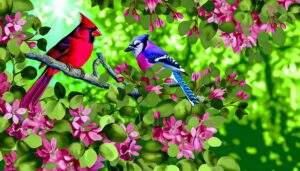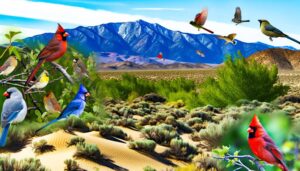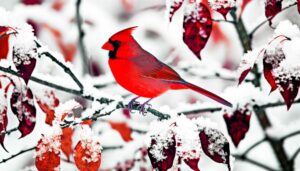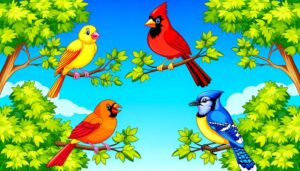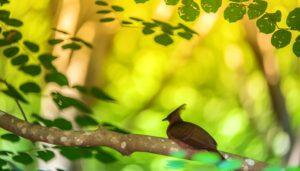Guide to Attract Blue Jays and Cardinals
To attract Blue Jays and Cardinals, use platform feeders for Blue Jays and feeders with ample perching space for Cardinals. Opt for seeds like sunflower and safflower, suet cakes, and fresh fruits.
Maintain clean bird baths and incorporate moving water features. Plant native vegetation such as oak trees and dogwoods to provide food and nesting sites.
Establish shelters like dense shrubbery, nesting boxes, and evergreens. Regularly clean all habitats and guarantee predator safety with measures like netting and baffles.
Implement these strategies to create an inviting environment for these vibrant birds to thrive and visit more.
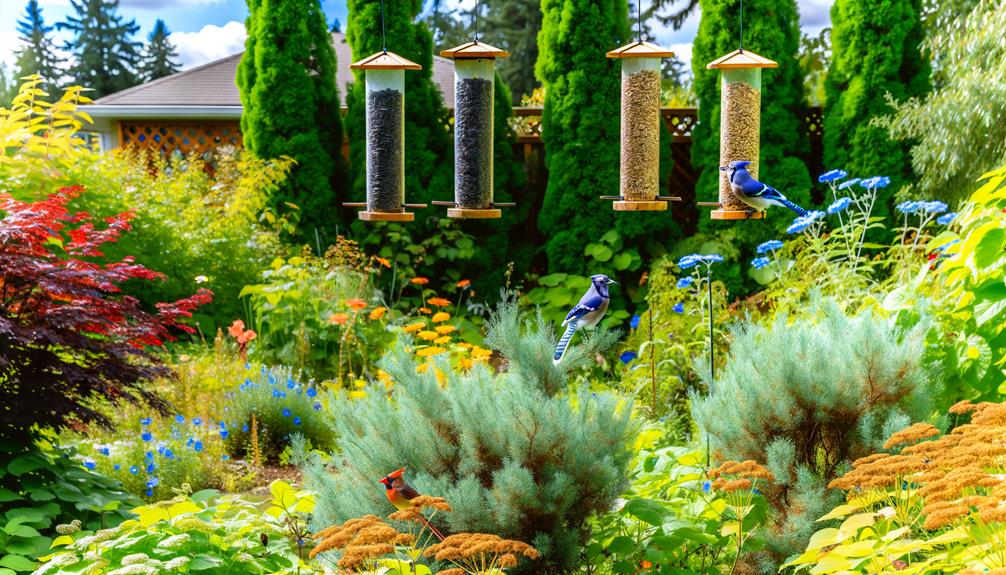
Key Takeaways
- Use platform feeders for Blue Jays and feeders with ample perching space for Cardinals.
- Provide a variety of high-quality seeds like sunflower and safflower seeds, along with fresh fruits and suet cakes.
- Maintain clean bird baths with fresh, shallow water and incorporate moving water features.
- Plant native vegetation such as oak trees and dogwoods for food sources and nesting sites.
- Implement predator safety measures like baffles, guards, and metal poles to protect birds.
Choose the Right Feeders
Selecting appropriate feeders is essential for attracting Blue Jays and Cardinals, as these birds exhibit specific feeding behaviors and preferences. Blue Jays prefer platform feeders or large hopper feeders that accommodate their size and allow easy access. These feeders should be sturdy to support their weight.
Cardinals, on the other hand, favor feeders with ample perching space, such as tube feeders with tray attachments or hopper feeders with extended perches. Both species benefit from feeders positioned at varying heights to replicate natural foraging conditions.
Ensuring feeders are constructed from durable materials, like metal or high-quality plastic, can withstand environmental stressors. Proper feeder selection fosters an inviting habitat, facilitating avian visitation and enhancing observational opportunities for bird enthusiasts.
Select Ideal Bird Food
To guarantee top-notch nutrition and attract Blue Jays and Cardinals, it is essential to provide a variety of high-quality food sources. Nutritious seeds such as sunflower and safflower seeds are highly favored by both species.
Additionally, incorporating fresh fruits and suet cakes into the feeding regimen can greatly enhance dietary diversity and energy intake.
Choose Nutritious Seeds
When attracting blue jays and cardinals, choosing seeds rich in essential nutrients like black oil sunflower seeds and safflower seeds guarantees peak health and crucial energy for these avian visitors. These seeds provide high-fat content and essential proteins, ensuring robust energy and best feather condition.
Additionally, incorporating a variety of seeds can cater to their diverse dietary needs.
- Black Oil Sunflower Seeds: High in fat content, promoting energy and shiny plumage.
- Safflower Seeds: Rich in protein, aiding muscle development and overall health.
- Peanuts: Packed with healthy fats and proteins, they are a favorite among blue jays.
- Cracked Corn: A carbohydrate source that supplements their energy requirements.
- Nyjer Seeds: Though smaller, they are nutrient-dense and attract various finches along with cardinals.
Offer Fresh Fruits
In addition to nutrient-rich seeds, providing fresh fruits such as oranges, apples, and berries can greatly enhance the appeal of your feeding station to blue jays and cardinals. These fruits not only offer essential vitamins and minerals but also provide hydration, which is crucial for avian health. The table below categorizes recommended fruits, their nutritional benefits, and preferred placement methods.
| Fruit | Nutritional Benefit | Placement Method |
|---|---|---|
| Oranges | Vitamin C, antioxidants | Sliced on platform |
| Apples | Fiber, Vitamin A | Chopped in feeders |
| Berries | Vitamins, antioxidants | Scattered on ground |
Understanding the dietary preferences and nutritional requirements of these birds can significantly boost their visitation rates, promoting a richer, more biodiverse backyard ecosystem.
Provide Suet Cakes
Suet cakes, rich in fat and protein, provide a crucial energy source for blue jays and cardinals, particularly during colder months when natural food sources are scarce. These high-caloric offerings are not only essential for maintaining body heat but also support metabolic health and reproductive success.
Observations indicate that incorporating diverse ingredients can enhance the attractiveness of suet cakes. Consider using:
- Berry blends: Incorporate dried berries to mimic natural foraging.
- Nuts and seeds: Add variety with sunflower seeds and peanuts.
- Insect inclusions: Mealworms can boost protein content.
- Grain additives: Oats and cornmeal offer additional carbohydrates.
- Flavor enhancers: Honey or peanut butter can increase palatability.
Providing such tailored nutrition fosters a dynamic ecosystem, benefiting avian diversity and encouraging vibrant bird populations.
Provide Fresh Water
Ensuring the provision of fresh water is essential for attracting Blue Jays and Cardinals to your garden.
Maintaining clean bird baths, incorporating moving water features such as fountains, and ensuring shallow water depth are key factors that cater to the birds' hydration and bathing needs.
These elements not only enhance the habitat's appeal but also promote the birds' health and well-being.
Clean Bird Baths
Maintaining clean bird baths with fresh water is essential for attracting Blue Jays and Cardinals, as it supports their hydration needs and promotes overall bird health. Regularly cleaned bird baths prevent the proliferation of harmful bacteria and parasites, guaranteeing a sanitary environment.
To optimize conditions for these avian visitors, consider the following:
- Frequency: Clean bird baths no less than once a week.
- Depth: Maintain a water depth of 1-2 inches to accommodate different bird sizes.
- Placement: Position baths in shaded areas to prevent rapid evaporation.
- Materials: Use non-porous materials like glazed ceramic to reduce algae growth.
- Scrubbing: Employ a scrub brush and mild detergent for thorough cleaning.
These measures secure a welcoming habitat, encouraging repeated visits from these vibrant species.
Moving Water Features
In addition to maintaining clean bird baths, incorporating moving water features can greatly enhance the attractiveness of your garden to Blue Jays and Cardinals by providing a consistent source of fresh water.
Features such as small fountains or waterfalls not only prevent stagnation but also create auditory and visual cues that attract these avian species. The movement of water helps to aerate it, reducing the growth of algae and bacteria, thereby ensuring a healthier drinking environment. Installing a recirculating pump system can achieve this effect with minimal maintenance.
Observations indicate that Blue Jays and Cardinals are particularly drawn to the sound and sight of flowing water, which mimics their natural habitats. This strategic addition can significantly increase their visitation frequency.
Shallow Water Depth
Providing fresh water at a shallow depth is necessary for attracting Blue Jays and Cardinals, as these birds prefer water sources that allow them to drink and bathe safely without the risk of drowning. Best water depth should range from 1 to 2 inches, guaranteeing accessibility and safety.
The presence of fresh water is essential for hydration and maintaining feather condition, which is crucial for thermoregulation and flight efficiency.
To create an ideal water source:
- Use shallow birdbaths with gentle slopes.
- Place flat stones or perches for secure footing.
- Change water daily to prevent contamination.
- Position the birdbath in a shaded area to maintain cool water.
- Ensure it is within sight but safe from predators.
Such attention to detail will create an inviting habitat, promoting avian visitation and biodiversity.
Plant Native Vegetation
Planting native vegetation is necessary for creating a habitat that supports the dietary and nesting needs of Blue Jays and Cardinals. Native plants, such as oak trees (Quercus spp.), provide acorns that are an important food source for Blue Jays, while the dense foliage of dogwoods (Cornus spp.) offers ideal nesting sites for Cardinals.
Native flora also supports a rich invertebrate community, providing protein-rich insects that are crucial during the breeding season. Additionally, indigenous plants are adapted to local climatic conditions, reducing the need for water and fertilizers, thereby promoting a sustainable environment.
Create Shelter Options
Establishing diverse shelter options is essential for accommodating the roosting and nesting behaviors of Blue Jays and Cardinals. These birds prefer environments that offer protection from predators and harsh weather conditions. Implementing a variety of shelter options will enhance habitat suitability and encourage prolonged residence.
- Dense Shrubbery: Planting thick shrubs like holly or juniper provides natural protection.
- Tree Canopies: Mature trees with expansive canopies offer excellent roosting spots.
- Birdhouses: Install birdhouses with appropriate entrance hole sizes to deter predators.
- Brush Piles: Create brush piles that mimic natural debris, offering ground-level shelter.
- Evergreens: Evergreen trees maintain foliage year-round, providing year-round cover.
These elements collectively create an inviting and secure environment for Blue Jays and Cardinals, supporting their natural behaviors and lifecycle needs.
Maintain a Clean Habitat
Regular habitat maintenance is essential for preventing the spread of disease and ensuring a healthy environment for Blue Jays and Cardinals. Routine cleaning of bird feeders, bird baths, and nesting areas mitigates the accumulation of pathogens such as Salmonella and avian pox.
Disinfect feeders with a solution of nine parts water to one part bleach, ensuring thorough rinsing and drying. Remove fallen seeds and debris to deter rodent infestations and mold growth. Regularly refresh water in bird baths to prevent mosquito breeding and algae proliferation.
Prune dead or diseased vegetation to reduce pest habitats and improve air circulation. These practices foster a balanced ecosystem, promoting the well-being and longevity of avian visitors while embracing the freedom of a healthy, clean habitat.
Use Bird-Friendly Landscaping
Implementing bird-friendly landscaping involves the strategic selection and placement of native plants, diverse vegetation layers, and natural food sources to create an inviting habitat for Blue Jays and Cardinals. By fostering an ecosystem that meets their needs, you can attract these vibrant birds.
Native plants are essential, as they provide the appropriate nutrition and shelter. Additionally, creating a diverse vertical structure with varying plant heights can mimic their natural habitat.
- Native shrubs: Offer food and nesting sites.
- Berry-producing plants: Supply essential sustenance.
- Deciduous trees: Provide perching and nesting opportunities.
- Evergreens: Offer year-round shelter and protection.
- Dense thickets: Serve as safe havens and nesting areas.
Careful planning can transform your landscape into a haven for these beautiful birds.
Ensure Safety From Predators
Creating a bird-friendly landscape is not complete without addressing the need to protect Blue Jays and Cardinals from potential predators, which can have a significant impact on their survival and well-being. Implementing safety measures is vital; consider options such as installing predator guards, located strategically around feeders and nesting sites, and utilizing dense shrubbery to offer concealment. Additionally, employing baffles on birdhouses can deter climbing predators like raccoons and snakes.
| Predator | Deterrent Method | Additional Notes |
|---|---|---|
| Cats | Enclosures, Netting | Keep feeders at least 10 feet high |
| Hawks | Covered Feeders, Trees | Provide dense canopy for quick escape |
| Raccoons | Baffles, Guards | Use metal poles to prevent climbing |
| Snakes | Baffles, Ground Guards | Clear ground debris around feeders |
| Squirrels | Squirrel Baffles | Position feeders away from jump points |
Conclusion
To sum up, attracting blue jays and cardinals requires a multifaceted approach, covering suitable feeders, best bird food, fresh water sources, native vegetation, and adequate shelter.
A case study in an urban park showed that incorporating native plants and keeping habitats clean notably boosted the presence of these bird species.
Adopting bird-friendly landscaping and ensuring predator safety are crucial.
This all-encompassing plan establishes a sustainable and welcoming environment, fostering the flourishing of blue jays and cardinals.

